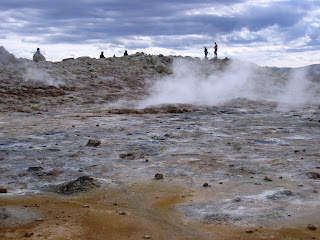We stopped first at Goðafoss, the waterfall of the gods – so named because, as the story goes, upon returning from the Althing where Iceland officially adopted Christianity a thousand years ago, the local chieftain of the region threw all his statues of pagan gods into the waterfall.
The on to the Námafjall geothermal area, with lots of fumaroles and bubbling mudpots. No matter how many times I see places like this, the strangeness of escaping gases and water heated by magma below my feet never ceases to astound me.
Icelanders have managed to take advantage of their unique geologic landscape by producing a large amount of their energy by using geothermally-heated water. The power plant at Krafla, the volcanic vent next to Lake Mývatn, was the first geothermal power plant in the country, beginning electricity production in 1978.
The smoke rising up in front of the mountain is from a production well, where basically they drill for steam, and to the right, you can see the very tip of the most recent lava flow from Krafla, erupted in the Krafla fires of 1975-1985.
The steam is then piped all across the area into the separator station, where the steam is filtered before being piped to the turbines. The steam pipes all across the landscape also have a strangely other-worldly look, like something out of a futuristic dystopian fantasy, although strangely juxtaposed with the sheep that were grazing in the grassy areas next to the tephra hills.
And then after the steam has been used to power the turbines and produce electricity, it is cooled in this series of giant cooling towers before being released.
This ability to produce large amounts of energy is basically Iceland’s other major natural resource in addition to the fisheries. Raw bauxite is shipped to Iceland from all over the world – even as far as Australia – to be smelted into aluminium using the cheaply available energy. According to Landsvirkjun, the company that operates the Krafla power plant (owned jointly by the Icelandic State, City of Reykjavik, and Town of Akureyri), 70% of electricity consumption in Iceland goes to power-intensive industrial development. Since 1999, Iceland has had the highest per capita electricity consumption in the world (a dubious distinction), though the amount of greenhouse gas emissions from the electricity production is far lower than in any other western nation, which the company uses to tout its geothermal power production as “an important contribution to the battle against the greenhouse effect.” Whether this type of industrial development is good for the country seems to be a rather common topic of debate, and I’m wary of saying that shipping aluminium around the world to be smelted in Iceland is a particularly environmentally-sound option, but it certainly is a unique resource.
We then headed to the Mývatn Naturebath, where we went swimming in a “natural spa” of warm, mineral-rich water similar to the Blue Lagoon near Reykjavik. I’m unconvinced that there is any health benefit to this kind of thing, but it was certainly relaxing to swim in the warm water (and after a rather cold and rainy morning, too) and the view out over the lava fields and the lake was pretty spectacular.
The view out over the nature bath, with Hverfell (the explosion crater Ada and I climbed) visible in the distance:
And me in the water, with some crazy Finns:
Last stop before we headed back to the coast to learn more about more oceanic things, we went to Dimmuborgir, an area of strange lava formations left behind when a former lava lake drained before it had fully solidified. Apparently the Yule Lads, the sons of two vicious trolls who live in the Mývatn area who are part of the Christmas traditions here (children leave shoes in the windowsill for the thirteen days before Christmas and each day a different Yule Lad comes to leave presents for well-behaved children and raw potatoes for misbehaving children), also live in Dimmuborgir, although I didn’t spot any of them while we were walking around.
The most famous of the formations is Kirkja, the church, a basalt archway.
And just as we were leaving, the rain cleared up and left us a very picturesque rainbow over the lava fields.











No comments:
Post a Comment